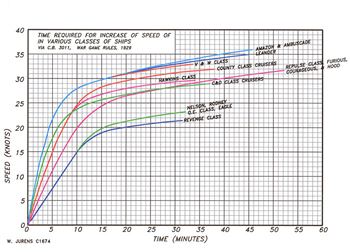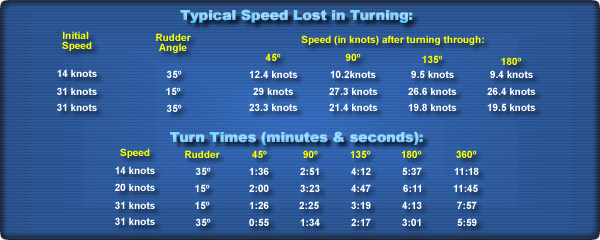
Performance (Speed, Range & Turning)
Designed Max. Horsepower: 32.07 knots / 59.4 km/h was achieved during a full power run on the Arran Mile, at a displacement of 42,000 tons / 42674.6MT and with Force 6 winds.
Average Top Speed: 31 knots / 57.4 km/h. During her 1939 Special Large Repair, the engines could still attain 144,000hp with a screw rotation of 197.6 rpm. By 1941 however, once more in dire need of an overhaul, Hood could only manage about 28.8 knots / 53.3 km/h.
Acceleration/Time Power Curve: The graph to the right was derived from CB 3011, Wargame Rules for 1929. It was provided by William Jurens of Warship International. Hood's power curve is shown in magenta. As one can see, it took time for Hood to work up to her top speed. This is generally true for any large warship of her era. Click to enlarge.
Un-refuelled Range: 4,500 nm / 8,334 km at 20 knots / 37 km/h or 5,000 nm / 9,260 km at 18 knots / 33.3 km/h.
Handling: As with just about any ship, Hood's turning performance varied according to conditions. To learn more about these, read Notes on Handling the "Hood".

Seakeeping
Hood was regarded as a good seaboat despite the fact that she sat nearly 4 feet deeper in the water than originally planned. The arrangement of her bows kept the fo'c's'le mostly dry except in heavy seas. In the high waves of such heavy seas, it was not uncommon for her bows to occasionally dip downward into the troughs between waves. As she came back up, she would literally shudder. As former crew member Dennis "Den" Finden described it, "She'd shake like a jelly (Jello)."
High seas and the dipping had a tendency to wreak havoc in places such as the sailors' heads (latrines): As Ken "Nobby" Clark and Ted Briggs both described it, if men were sitting on the "toilets" and she dipped, the experienced matelots would quickly stand up...lest "they got their 'own' back" (or worse, someone else's!). Such conditions were made all the worse by clogged drains, in which case the floor would be flooded with all sorts of nasty things from the toilets, seawater and the showers.
The most apparent seakeeping problem was the quarterdeck. Due to the greater than designed weight/displacement, the forward edge of the deck was situated precariously above sea level. To top it off, the stern also had a tendency to "dig-in" somewhat when at speed. It was therefore frequently awash and inhabitable in moderate seas or even calm waters if the ship was at speed. On one occasion, the water was so heavy that it entered the mushroom vents and actually flooded the gunroom (Midshipmans quarters). Because of this problem, she was jokingly referred to as the "largest submarine afloat."
Over time as her weight increased, and the distance between the waterline and the deck receded, she grew to be more wet. Despite her problems, she was reputed to be a steady gunnery platform.